<xmp>
<body><!--'"</title></head>-->
<script type="text/javascript">
//OwnerIQ
var __oiq_pct = 50;
if( __oiq_pct>=100 || Math.floor(Math.random()*100/(100-__oiq_pct)) > 0 ) {
var _oiqq = _oiqq || [];
_oiqq.push(['oiq_addPageBrand','Lycos']);
_oiqq.push(['oiq_addPageCat','Internet > Websites']);
_oiqq.push(['oiq_addPageLifecycle','Intend']);
_oiqq.push(['oiq_doTag']);
(function() {
var oiq = document.createElement('script'); oiq.type = 'text/javascript'; oiq.async = true;
oiq.src = document.location.protocol + '//px.owneriq.net/stas/s/lycosn.js';
var s = document.getElementsByTagName('script')[0]; s.parentNode.insertBefore(oiq, s);
})();
}
//Google Analytics
var _gaq = _gaq || [];
_gaq.push(['_setAccount','UA-21402695-19']);
_gaq.push(['_setDomainName','tripod.com']);
_gaq.push(['_setCustomVar',1,'member_name','sirocco31',3]);
_gaq.push(['_trackPageview']);
(function() {
var ga = document.createElement('script'); ga.type = 'text/javascript'; ga.async = true;
ga.src = ('https:' == document.location.protocol ? 'https://ssl' : 'http://www') + '.google-analytics.com/ga.js';
var s = document.getElementsByTagName('script')[0]; s.parentNode.insertBefore(ga, s);
})();
//Lycos Init
function getReferrer() {
var all= this.document.cookie;
if (all== '') return false;
var cookie_name = 'REFERRER=';
var start = all.lastIndexOf(cookie_name);
if (start == -1) return false;
start += cookie_name.length;
var end = all.indexOf(';', start);
if (end == -1) end = all.length;
return all.substring(start, end);
}
function getQuery() {
var rfr = getReferrer();
if (rfr == '') return false;
var q = extractQuery(rfr, 'yahoo.com', 'p=');
if (q) return q;
q = extractQuery(rfr, '', 'q=');
return q ? q : "";
}
function extractQuery(full, site, q_param) {
var start = full.lastIndexOf(site);
if (start == -1) return false;
start = full.lastIndexOf(q_param);
if (start == -1) return false;
start += q_param.length;
var end = full.indexOf('&', start);
if (end == -1) end = full.length;
return unescape(full.substring(start, end)).split(" ").join("+");
}
function generateHref(atag, template){
atag.href=template.replace('_MYURL_', window.location.href.replace('http://', '')).replace('_MYTITLE_','Check%20out%20this%20Tripod%20Member%20site!');
}
var lycos_ad = Array();
var lycos_onload_timer;
var cm_role = "live";
var cm_host = "tripod.lycos.com";
var cm_taxid = "/memberembedded";
var tripod_member_name = "sirocco31";
var tripod_member_page = "sirocco31/html/design.htm";
var tripod_ratings_hash = "1766489916:702863a471add220ae2dab6ac2b4f2be";
var lycos_ad_category = null;
var lycos_ad_remote_addr = "209.202.244.9";
var lycos_ad_www_server = "www.tripod.lycos.com";
var lycos_ad_track_small = "";
var lycos_ad_track_served = "";
var lycos_search_query = getQuery();
</script>
<script type="text/javascript" src="https://scripts.lycos.com/catman/init.js"></script>
<script type='text/javascript'>
var googletag = googletag || {};
googletag.cmd = googletag.cmd || [];
(function() {
var gads = document.createElement('script');
gads.async = true;
gads.type = 'text/javascript';
var useSSL = 'https:' == document.location.protocol;
gads.src = (useSSL ? 'https:' : 'http:') +
'//www.googletagservices.com/tag/js/gpt.js';
var node = document.getElementsByTagName('script')[0];
node.parentNode.insertBefore(gads, node);
})();
</script>
<script type='text/javascript'>
googletag.cmd.push(function() {
googletag.defineSlot('/95963596/TRI_300X250_dfp', [300, 250], 'div-gpt-ad-1450204159126-0').addService(googletag.pubads());
googletag.defineSlot('/95963596/TRI_above_728x90_dfp', [728, 90], 'div-gpt-ad-1450204159126-1').addService(googletag.pubads());
googletag.defineSlot('/95963596/TRI_below_728x90_dfp', [728, 90], 'div-gpt-ad-1450204159126-2').addService(googletag.pubads());
googletag.pubads().enableSingleRequest();
googletag.enableServices();
});
</script>
<script type="text/javascript">
(function(isV)
{
if( !isV )
{
return;
}
var adMgr = new AdManager();
var lycos_prod_set = adMgr.chooseProductSet();
var slots = ["leaderboard", "leaderboard2", "toolbar_image", "toolbar_text", "smallbox", "top_promo", "footer2", "slider"];
var adCat = this.lycos_ad_category;
adMgr.setForcedParam('page', (adCat && adCat.dmoz) ? adCat.dmoz : 'member');
if (this.lycos_search_query)
{
adMgr.setForcedParam("keyword", this.lycos_search_query);
}
else if(adCat && adCat.find_what)
{
adMgr.setForcedParam('keyword', adCat.find_what);
}
for (var s in slots)
{
var slot = slots[s];
if (adMgr.isSlotAvailable(slot))
{
this.lycos_ad[slot] = adMgr.getSlot(slot);
}
}
adMgr.renderHeader();
adMgr.renderFooter();
}((function() {
var w = 0, h = 0, minimumThreshold = 300;
if (top == self)
{
return true;
}
if (typeof(window.innerWidth) == 'number' )
{
w = window.innerWidth;
h = window.innerHeight;
}
else if (document.documentElement && (document.documentElement.clientWidth || document.documentElement.clientHeight))
{
w = document.documentElement.clientWidth;
h = document.documentElement.clientHeight;
}
else if (document.body && (document.body.clientWidth || document.body.clientHeight))
{
w = document.body.clientWidth;
h = document.body.clientHeight;
}
return ((w > minimumThreshold) && (h > minimumThreshold));
}())));
window.onload = function()
{
var f = document.getElementById("FooterAd");
var b = document.getElementsByTagName("body")[0];
b.appendChild(f);
f.style.display = "block";
document.getElementById('lycosFooterAdiFrame').src = '/adm/ad/footerAd.iframe.html';
// DOM Inj Ad
(function(isTrellix)
{
var e = document.createElement('iframe');
e.style.border = '0';
e.style.margin = 0;
e.style.display = 'block';
e.style.cssFloat = 'right';
e.style.height = '254px';
e.style.overflow = 'hidden';
e.style.padding = 0;
e.style.width = '300px';
var isBlokedByDomain = function( href )
{
var blockedDomains = [
"ananyaporn13000.tripod.com",
"xxxpornxxx.tripod.com"
];
var flag = false;
for( var i=0; i<blockedDomains.length; i++ )
{
if( href.search( blockedDomains[ i ] ) >= 0 )
{
flag = true;
}
}
return flag;
}
var getMetaContent = function( metaName )
{
var metas = document.getElementsByTagName('meta');
for (i=0; i<metas.length; i++)
{
if( metas[i].getAttribute("name") == metaName )
{
return metas[i].getAttribute("content");
}
}
return false;
}
var getCommentNodes = function(regexPattern)
{
var nodes = {};
var nodesA = [];
var preferredNodesList = ['a', 'c', 'b'];
(function getNodesThatHaveComments(n, pattern)
{
if (n.hasChildNodes())
{
if (n.tagName === 'IFRAME')
{
return false;
}
for (var i = 0; i < n.childNodes.length; i++)
{
if ((n.childNodes[i].nodeType === 8) && (pattern.test(n.childNodes[i].nodeValue)))
{
var areaName = pattern.exec(n.childNodes[i].nodeValue)[1];
nodes[areaName] = n;
}
else if (n.childNodes[i].nodeType === 1)
{
getNodesThatHaveComments(n.childNodes[i], pattern);
}
}
}
}(document.body, regexPattern));
for (var i in preferredNodesList)
{
if (nodes[preferredNodesList[i]])
{
if( isTrellix && nodes[preferredNodesList[i]].parentNode.parentNode.parentNode.parentNode )
{
nodesA.push(nodes[preferredNodesList[i]].parentNode.parentNode.parentNode.parentNode);
}
else
{
nodesA.push( nodes[preferredNodesList[i]] );
}
}
}
return nodesA;
}
var properNode = null;
var areaNodes = getCommentNodes( new RegExp( '^area Type="area_(\\w+)"' ) );
for (var i = 0; i < areaNodes.length; i++)
{
var a = parseInt(getComputedStyle(areaNodes[i]).width);
if ((a >= 300) && (a <= 400))
{
properNode = areaNodes[i];
break;
}
}
var propertyName = getMetaContent("property") || false;
if( isTrellix && (properNode) )
{
e.src = '/adm/ad/injectAd.iframe.html';
properNode.insertBefore(e, properNode.firstChild);
}
else if( isTrellix && !( properNode ) ) // Slap the ad eventhought there is no alocated slot
{
e.src = '/adm/ad/injectAd.iframe.html';
e.style.cssFloat = 'none';
var cdiv = document.createElement('div');
cdiv.style = "width:300px;margin:10px auto;";
cdiv.appendChild( e );
b.insertBefore(cdiv, b.lastChild);
}
else if( !isBlokedByDomain( location.href ) )
{
var injF = document.createElement('iframe');
injF.style.border = '0';
injF.style.margin = 0;
injF.style.display = 'block';
injF.style.cssFloat = 'none';
injF.style.height = '254px';
injF.style.overflow = 'hidden';
injF.style.padding = 0;
injF.style.width = '300px';
injF.src = '/adm/ad/injectAd.iframe.html';
if( b && ( !isTrellix || ( typeof isTrellix == "undefined" ) ) ) // All other tripod props
{
var cdiv = document.createElement('div');
cdiv.style = "width:300px;margin:10px auto;";
cdiv.appendChild( injF );
b.insertBefore(cdiv, b.lastChild);
}
}
}( document.isTrellix ));
}
</script>
<div id="tb_container" style="background:#DFDCCF; border-bottom:1px solid #393939; position:relative; z-index:999999999!important">
<!--form name="search" onSubmit="return searchit()" id='header_search' >
<input type="text" placeholder="Search" size=30 name="search2" value="">
<input type="button" value="Go!" onClick="searchit()">
</form>
<style>
form#header_search {
width: 916px;
margin: 0 auto 8px;
position: relative;
}
form#header_search input {
height: 40px;
font-size: 14px;
line-height: 40px;
padding: 0 8px;
box-sizing: border-box;
background: #F4F2E9;
border: 1px solid #BBB8B8;
transition: background-color 300ms ease-out,
color 300ms ease;
}
form#header_search input[type="text"] {
width: 100%;
}
form#header_search input[type="text"]:focus {
border-color: #A2D054;
background-color: #fff;
box-shadow: 0 0px 12px -4px #A2D054;
}
form#header_search input[type="button"] {
position: absolute;
top: 1px;
right: 1px;
opacity: 1;
background: #DFDCCF;
color: #463734;
width: 125px;
cursor: pointer;
height: 38px;
border: none;
}
form#header_search input[type="text"]:focus ~ input[type='button']:hover,
form#header_search input[type='button']:hover {
background-color: #A5CE56;
color: #fff;
}
form#header_search input[type="text"]:focus ~ input[type='button'] {
background-color: #52AEDF;
color: #fff;
}
</style>
<script>
function searchit(){
// determine environment
var search_env
if (lycos_ad_www_server.indexOf(".pd.") > -1) {
search_env = 'http://search51.pd.lycos.com/a/';
} else if (lycos_ad_www_server.indexOf(".qa.") > -1) {
search_env = 'http://search51.qa.lycos.com/a/';
} else {
search_env = 'http://search51.lycos.com/a/';
}
var search_term = encodeURIComponent(document.search.search2.value)
var search_url = search_env+search_term;
window.open(search_url);
return false
}
</script-->
<style>
.adCenterClass{margin:0 auto}
</style>
<div id="tb_ad" class="adCenterClass" style="display:block!important; overflow:hidden; width:916px;">
<div id="ad_container" style="display:block!important; float:left; width:728px ">
<script type="text/javascript">
if (typeof lycos_ad !== "undefined" && "leaderboard" in lycos_ad) {
document.write(lycos_ad['leaderboard']);
}
</script>
</div>
</div>
</div>
<script type="text/javascript">
if (typeof lycos_ad !== "undefined" && "slider" in lycos_ad) {
document.write(lycos_ad['slider']);
}
</script> <!-- added 7/22 -->
<div id="FooterAd" style="background:#DFDCCF; border-top:1px solid #393939; clear:both; display:none; width:100%!important; position:relative; z-index:999999!important; height:90px!important">
<div class="adCenterClass" style="display:block!important; overflow:hidden; width:916px;">
<div id="footerAd_container" style="display:block!important; float:left; width:728px">
<iframe id="lycosFooterAdiFrame" style="border:0; display:block; float:left; height:96px; overflow:hidden; padding:0; width:750px"></iframe>
</div>
</div>
</div>
</body>
</xmp>
Sirocco 31, designed by Angus Primrose
Design
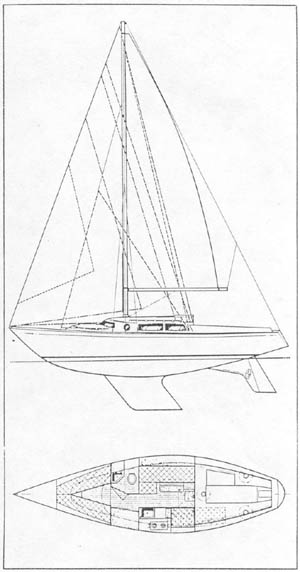 |
|
The Sirocco 31 was designed by
Angus Primrose, a renowned architect. She was designed
under the half-ton class. Some further specifications:
- L.O.A. = 31 ft / 9m60
- Draft = 5ft 6 / 1m70
- Beam = 9ft 3 / 2m86
- Height = 10 m (mast) / 13m
(bridge clearance)
- Displacement = 6,500 lb /
3.000 kg
- Ballast = 3.040 lb / 1.382 kg
- Sail Area = 315 sq ft / 29,2
mē
- Engine = Volvo Penta 20001,
9.9 hp inboard diesel
|
I'll try to give an objective review here.
This is easier than it sounds. Being her owner, this gives me a
rather biased view of her capacities.
Sailing Properties
As said before, her age doesn't affect her
speed, on the contrary. The maximum speed we ever got out of here
was an impressive 12.8 kts. Okay, I'm cheating here, that speed
over ground, with the current spitting us out of the Solent at
full blast, with the needles in full view. What a ride that was.
She averages a good 5 kts, with a decent 7 as top speed. I
haven't been able to try out the spinnaker, so there's still room
for improvement there :-)
The Obi-Wan is a cruiser/racer. Which means
you can comfortably maintain a decent speed of about 4,5 kts. If
you want to go faster, start concentrating. It takes a good trim
to get her going. She's well balanced, though. There's a groove
in the middle of the underside of th traveller, which can be used
to block the helm. With the sails properly trimmed, we managed to
hold course for over half an hour. Who needs autopilots after
that !
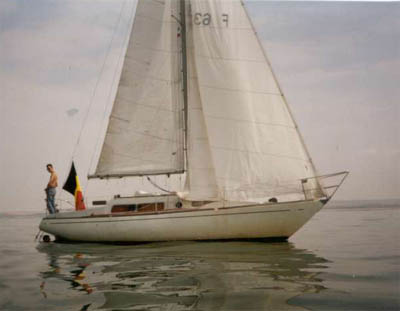 |
The Obi-Wan carries the following
sail inventory:
- Spinnaker - Running, apparent
wind up to 100°/1-3 bft
- Genoa 1 - 1-3 bft
- Genoa 2 - 3-5 bft
- Jib 1 - 5 - 6
- Jib 2 - 6 - 8
- Trysail - 8 and above (hope I
never have to use this one)
|
The first reef goes into the mainsail at 5
bft, the second at 7 bft.
She's not the fastest boat through the
tack, it requires practice. This is mainly caused by the rather
long keel, and the fact that the helm can only be pushed to 32°,
because of the layout. The helm is attached to the rudder at the
bottom of the cockpit. The S-shape of the helm manages to give
you some latitude, but there's no getting around the benches.
Manoeuvring under engine
| Here's where it gets
tricky. First of all, 9 hp isn't exactly overpowered. I
now believe that you need at least 4 hp per ton of
displacement. So a 12 or 15 hp engine would be better.
The maximum speed under engine is about 5.4 knots. On the
other hand , if you go faster under engine, you're
probably more like to turn the thing on, and that's not
what its all about. Second of
all, the propwalk is unbelievable. She's a leftie, which
means she pulls to starboard when going astern. But if
you know how to anticipate this, you can actually
benefit. Using the propwalk I can turn her around on the
spot. But mooring her to port takes a lot of seamanship.
The fact that she's powered by a
one cylinder Volvo Penta 2001 doesn't improve the noise
either. The engine causes quite a lot of vibrations.
Checking the engine mounts is a annual job. But that goes
for all engines.
On the other hand, the engine
practically runs on drops. About 1l of fuel per hour.
|
 |
| The Cockpit The cockpit has room for four people, five
when in racing mode. The well isn't as wide as on yachts
of a more recent design, but this just improves your
ability to brace your legs.
The first thing you notice is the
fact that the main genoawinch is situated in the middle
of the cockpit bench. My first impression was that this
is the worst place to put a winch. I immediately had
visions of bruised shins. In fact, I wouldn't want it any
other way now. Trimming the headsail is as easy a putting
your magazine down, and giving the two-speed winch a few
turns. No more having to go down to the leeward side,
leaning out and running the risk of getting clobbered by
a rogue wave. All is done from the safety of the cockpit.
Racing is another matter, though. Since there is no
dedicated winch for each sheet, the windward sheet has to
be removed completely before the leeward sheet can be
applied. Co-ordination is the keyword here.
The traveller was originally
trimmed with stoppers. But this was difficult to regulate
under heavy sail. So I replaced it with blocks and
cleats. It now functions excellently.
|
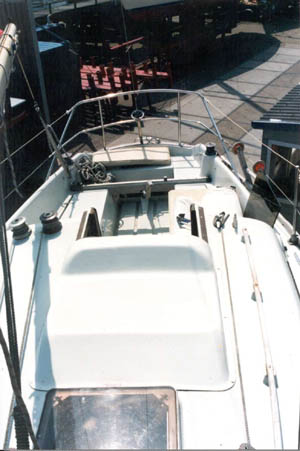 |
The 14mm sheet is run through a 4-to-1
purchase.
On the starboard side a large locker which
contains the sail inventory and the warps. The port locker is
half it size, because of the bunk layout (of which more later).
It contains the safety equipment: flares, fire extinguisher; and
the fuel jerrycan. Keeping the fire extinguisher next to 40l of
fuel isn't exactly a great idea, but on a 31ft boat, the fuel
will always be close to the extinguisher. Behind the traveller is
another locker. This provides seating for the mainsheet and
traveller trimmer. It used to house the liferaft. But, being a
1973 original it was in a rather sorry state, so I took it out.
It now contains the extra anchor warps and chain. This balances
out the nose. The Sirocco 31 has a tendency to put her nose down
as soon as you put some weight in the forward cabin. To port and
starboard of the stern locker are the spinnaker winches.
Instruments
There used to be a full wind
instrumentation, but that kind of died during the years. I
removed the mast mounted sensor, and used the free space to
install a tricolour nav light. In 2001, I replaced the Seafarer sonar with a digital depth sounder. The Seafarer could only be installed inside. So if you were sailing in shallow waters, you had to keep one eye inside, and one outside. Difficult, to say the least. Now there's a digital readout on the dash. I also removed one of the defective wind meters, and replaced it with a GPS repeater. So COG, VOG, bearing and distance to waypoint are immediately accessible. Before that, I kept my handheld GPS in the cockpit, unprotected from the elements. I went through two handhelds like that.
- Compass: Plastimo contest, bulkhead
mounted
- Log: Plastimo Shark
- Sonar: NASA Clipper Depth
- GPS: Magellan 320 with a NASA Clipper repeater on the dashboard
- VHF: ICOM 59
The Deck
The entrance is slightly offset to port.
This shows the attention that Angus Primrose paid to the
ergonomics of living aboard. Had the entrance been spot in the
middle, the central winch would indeed have caused a lot of
bruises.
To starboard of the hatch are two winches
for the halyards of the headsails and the spinakker. To port are
two cleats, for the cunningham and the boomlift. The mainsail
halyard is tensioned on a mastbase winch. Just behind the mast is
a skylight. In front of the mast is a hatch, which leads to the
fo'c'sle. Ideal for taking down the spinakker, and sleeping under
the stars on a summer night.
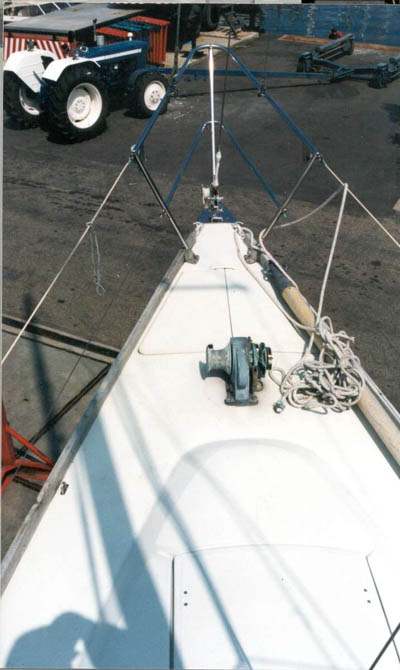 |
Forward is a anchor
winch, installed by the previous owner. Originally there
was a central clamp. This was removed to make room for
the winch. Because both anchor lockers are in front of
the winch, the anchor rode has to make a 180° turn to
end up in the locker. This leads the chain to clog every
two feet. Not the most efficient installation. To make
matters worse, the previous owner never replaced the
clamp, using instead the winch. This was quickly amended.
A sturdy clamp now sits to the right of the winch. The headsails are hanked on. No furling reef
for this boat. Agreed, it is more work, but it improves
the speed, and I always have this fear of furling reefs,
that they'll unroll themselves in a gale. Thousand of
sailors will probably disrepute this, and point to the
dangers of crawling across a wet deck, but that's my
choice. Besides, I'm the skipper. I have a crew to that
job :-)
|
| The Interior The rather steep stairs hide the engine.
Removing these give you perfect access to the engine for
maintenance. The gearbox and propshaft can be reached via
the starboard cockpit locker and the port berth.
Immediately to port of the stairs is a bunk. This also
doubles as a seat and the nav station. The chart table
faces outward to port, and swings into three positions:
- folded against the hull = bunk
- folded vertically = back of
the seat
- locked in the upward position
= nav station
|
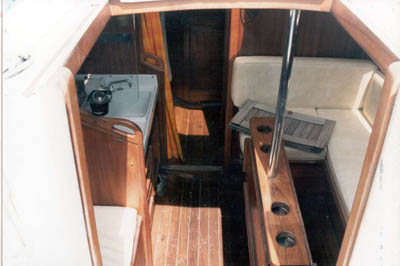 |
| I usually leave the card table
locked in the upward position. In that configuration you
can still use the bunk by crawling underneath the chart
table. Further forward, on
the port side is the galley. A two pits alcohol stove, a
sink and running cold water are all the mod cons the
ships cook (yours truly) needs.
|
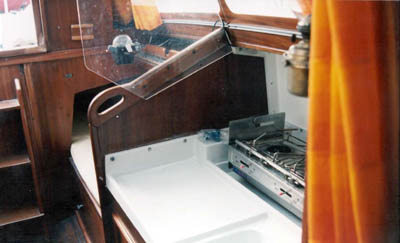 |
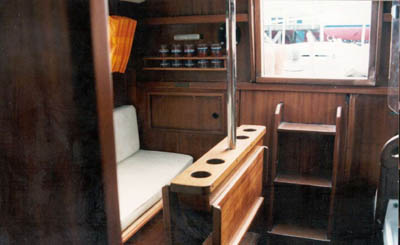 |
The starboard side of the main
cabin is taken up by the folding table, and a seat. The
backrest of wich can be removed, and placed beteen the
seat and the table, thus turning it into a double berth.
Again, hats off to Angus Primrose. |
Going forward from the main cabin, you'll
find a wet locker on the port side miships, and the bathroom on
the left. The bathroom is equiped with a head and a sink. The
faucet doubles as shower. No hot water, but excellent for washing
of the salt after a summer swim.
The fo'c'scle is a wall-to-wall double
berth. Several lockers provide plenty of space for the books, so
the fo'c'scle doubles as library.
I hope this has given you a good impression
of the Sirocco 31. You can find more images in the
"lookout"-section.






